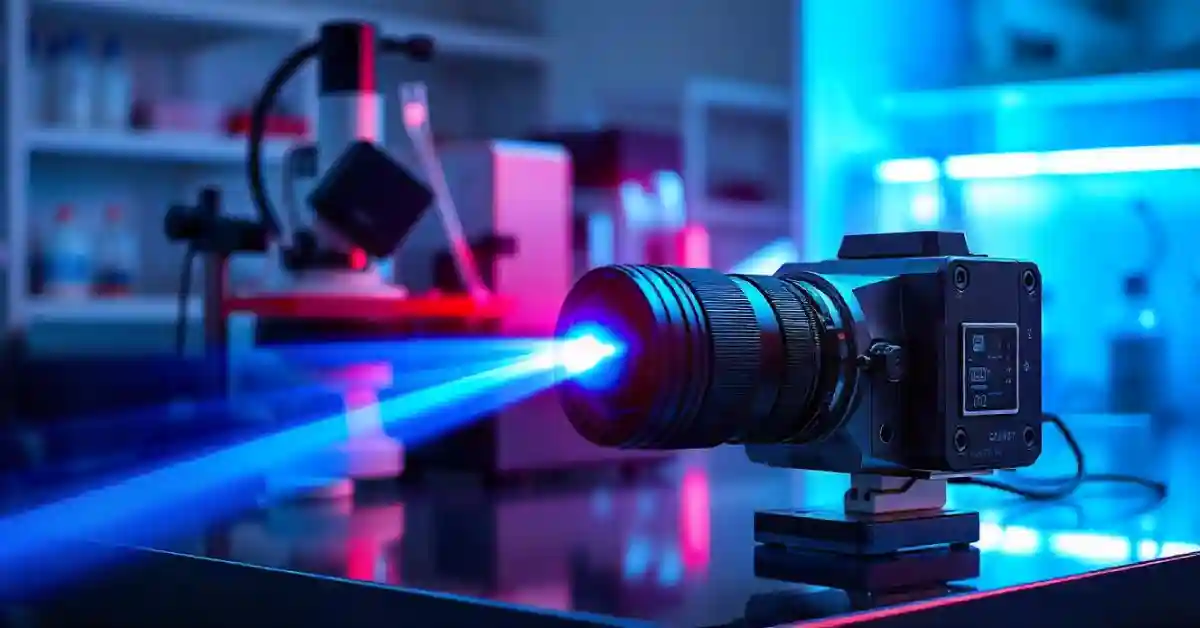In the rapidly evolving field of scientific research, imaging technology plays a crucial role in enhancing our understanding of complex phenomena. One of the most promising advancements in this arena is the development of the 266-1100 nm camera, which offers unique capabilities for capturing data across a broad spectrum. This article delves into the core aspects of this technology, its advantages, applications, and future prospects.
Understanding the 266-1100 nm Camera
The 266-1100 nm camera is designed to capture images across a wide wavelength range, from the ultraviolet (UV) to the near-infrared (NIR). This versatility is essential for various scientific applications, allowing researchers to observe and analyze materials that may not be visible with standard imaging equipment. The ability to visualize light beyond the visible spectrum opens up new avenues for exploration in fields such as biology, materials science, and environmental monitoring, where traditional imaging methods may fall short.

By utilizing advanced optics and specialized sensors, these cameras can detect specific wavelengths of light that are absorbed or emitted by different substances. This makes them invaluable for qualitative and quantitative analysis in many scientific disciplines. For instance, in biological studies, researchers can monitor cellular processes by observing fluorescence in the UV range, while in materials science, they can analyze the thermal properties of materials by capturing infrared emissions. Such capabilities enable a deeper understanding of complex phenomena and contribute to advancements in technology and research methodologies.
The Technology Behind the 266-1100 nm Camera
At the heart of the 266-1100 nm camera’s capabilities is its sensor technology. These cameras typically use charge-coupled device (CCD) or complementary metal-oxide-semiconductor (CMOS) sensors, which are engineered to operate efficiently across the specified wavelength range. The inclusion of optical filters enhances the specificity of the captured images, allowing researchers to target particular spectral bands. This targeted approach is crucial for applications such as remote sensing, where distinguishing between different materials based on their spectral signatures can lead to significant insights into environmental changes.
Furthermore, the integration of high-performance optics ensures that image quality is preserved, even when operating at the extreme ends of the spectrum. This technology provides scientists with a powerful tool for detailed investigations and insights into material behaviors and characteristics. The precision of these optics minimizes aberrations and maximizes resolution, enabling researchers to capture fine details that might otherwise be lost. As a result, the 266-1100 nm camera is not just a tool for observation but a gateway to understanding the underlying principles governing various scientific phenomena.
Key Features of the 266-1100 nm Camera
The versatility of the 266-1100 nm camera is underscored by several key features that enhance its functionality. These include:
- Wide Dynamic Range: This feature allows the camera to capture a broad range of light intensities, ensuring that both bright and dim features can be observed simultaneously.
- High Sensitivity: The camera’s sensors are designed to detect low levels of light, making them suitable for applications in dimly lit environments.
- Fast Acquisition Rates: Rapid image capture capabilities enable real-time analysis, essential for dynamic studies.
- Robust Software Integration: Advanced software tools accompany these cameras, facilitating data analysis and image processing.
These features collectively enhance the camera’s usability in various scientific disciplines, ensuring that researchers can extract meaningful data efficiently. Additionally, the camera’s compatibility with various imaging techniques, such as hyperspectral imaging and fluorescence microscopy, further broadens its application scope. This adaptability allows scientists to tailor their imaging strategies to specific research questions, making the 266-1100 nm camera a versatile asset in the laboratory. Moreover, the continuous advancements in sensor technology and image processing algorithms promise to further enhance the capabilities of these cameras, paving the way for even more innovative applications in the future.
Advantages of Using the 266-1100 nm Camera in Scientific Imaging
Utilizing the 266-1100 nm camera comes with several notable advantages, making it an attractive option for scientists across multiple fields. The following sections explore some of these key benefits.

Enhanced Image Quality and Resolution
One of the primary benefits of the 266-1100 nm camera lies in its ability to deliver exceptional image quality and resolution. The high-resolution capabilities allow for the detection of fine details that might be missed by standard imaging systems. This becomes particularly important in applications such as microscopy, where clarity is crucial.
Moreover, the ability to analyze images captured across a wide range of wavelengths contributes to a more comprehensive understanding of the subject matter. Researchers can gather multifaceted data that highlights features otherwise obscured in the visible spectrum. For instance, in biological studies, this capability allows for the visualization of cellular structures and processes that are not visible under traditional light microscopy, thereby enhancing the overall understanding of cellular behavior and interactions.
Broad Spectrum Imaging Capabilities
The broad spectrum imaging capabilities of this camera enable scientists to conduct detailed investigations into various materials and processes. By capturing images across wavelengths from 266 nm to 1100 nm, researchers can explore phenomena such as fluorescence, reflectance, and absorption effectively.
This extensive range is particularly beneficial in fields such as material science, where understanding the optical properties of materials is critical. The ability to capture both UV and infrared spectral information provides a holistic view of the materials under examination. Additionally, this versatility allows for the analysis of complex samples, such as biological tissues or composite materials, where different components may exhibit unique optical characteristics. This can lead to groundbreaking discoveries in fields like pharmacology, where understanding drug interactions at a molecular level is essential.
Real-Time Data Collection and Analysis
Another significant advantage is the camera’s capability for real-time data collection and analysis. This means that researchers can visualize and interpret their findings as they occur, rather than waiting for post-processing. Such immediacy is invaluable in experimental setups where conditions change rapidly.
Real-time analysis also facilitates quicker decision-making in experimental procedures, helping optimize methods, protocols, and other aspects of scientific inquiry. This feature significantly accelerates the research process, enabling scientists to test hypotheses and refine experiments more efficiently. Furthermore, the integration of advanced software tools with the camera allows for immediate adjustments to imaging parameters, ensuring that researchers can adapt to evolving experimental conditions on the fly. This adaptability not only enhances the quality of the data collected but also empowers scientists to push the boundaries of their research, leading to innovative approaches and solutions in their respective fields.
Potential Applications of the 266-1100 nm Camera
The versatility of the 266-1100 nm camera opens the door to numerous applications across diverse scientific fields. Below, we highlight several key areas where this technology is making significant impacts.
Use in Biological and Medical Research
In biological and medical research, cameras that can capture images across a wide spectrum are invaluable. They can be used for applications such as fluorescence microscopy, which allows for the visualization of cellular structures and processes.
The ability to detect various wavelengths also aids in monitoring biochemical interactions within live cells, leading to breakthroughs in understanding disease mechanisms and treatment responses.
Role in Environmental and Earth Sciences
The 266-1100 nm camera also plays a vital role in environmental monitoring and earth sciences. For instance, it can be used to analyze soil compositions, assess plant health, and monitor water quality.
By capturing multispectral data, scientists can create more detailed models of ecological systems and better understand human impacts on the environment. This capacity for comprehensive analysis is essential for informed decision-making in conservation and resource management.
Contribution to Astrophysics and Space Exploration
Furthermore, in astrophysics and space exploration, the broad spectral capabilities of these cameras enable the analysis of distant celestial objects. By detecting emissions from distant stars and galaxies, researchers can gather crucial information about the cosmos.
Applications include spectroscopy and imaging of celestial phenomena, which contribute to our understanding of the universe’s origins, evolution, and composition. Such insights are fundamental to expanding our knowledge of astrophysical processes.
Future Prospects of the 266-1100 nm Camera
As technology continues to advance, the future prospects for the 266-1100 nm camera are promising. Researchers are poised to exploit its full potential in numerous ways, leading to further discoveries and innovations in scientific inquiry.

Emerging Trends in Scientific Imaging
Emerging trends such as artificial intelligence and machine learning are likely to integrate seamlessly with the capabilities of the 266-1100 nm camera. These technologies can enhance image analysis and interpretation, allowing for the identification of patterns and trends in complex datasets with unprecedented efficiency.
This synergy between imaging technology and data analysis will revolutionize various fields, making research not only faster but also more precise and comprehensive.
Potential for Further Technological Advancements
Furthermore, ongoing advancements in sensor technology, optics, and computational imaging are expected to enhance the performance of the 266-1100 nm camera. Improvements in sensor sensitivity and resolution, coupled with innovative lens designs, will likely expand the camera’s capabilities even further.
We can expect to see developments that cater specifically to niche applications, providing tailored solutions for scientists in specialized fields.
The 266-1100 nm Camera and the Future of Scientific Research
Ultimately, the 266-1100 nm camera represents a significant leap forward in scientific imaging technology. Its ability to capture a broad range of wavelengths provides researchers with powerful tools to explore and understand the world around them in ways that were previously unimaginable.
As we move into a future characterized by rapid technological innovations, the promise of this camera is immense, offering new pathways for discovery and scientific advancement across numerous disciplines. By harnessing its capabilities, scientists can continue to push the boundaries of knowledge, leading the charge in some of the most pressing research areas of our time.










